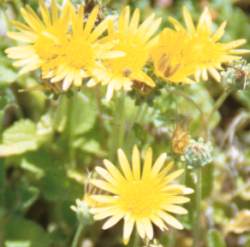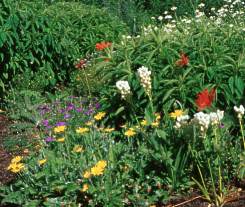Arctotis arctotoides
Arctotis arctotoides (L.f.) O.Hoffm.
Family: Asteraceae
Common names: butterflower (English), botterblom (Afrikaans), putswa-pududu (South Sotho), ubushwa, isigwamba (isiXhosa)
Introduction
Arctotis arctotoides is a fast-growing, soft, herbaceous groundcover that forms carpets of light green foliage decorated with cheerful, butter-yellow daisy flowers almost all year round.

Description
Description
The leaves are 10-15 cm long with a wavy edge, the upper surface a fresh light green, while the undersides are white and felted, with the midrib quite prominent. The leaves and stems are covered with small white hairs. The single daisy flowers are formed on stems that are about 20 cm long. Each flower is about 4 cm in diameter and the centre and the petals, or ray florets, are a bright golden yellow. The undersides of the petals are purplish brown and are clearly visible when the flowers are in bud or closed during a cloudy day.

Every flower lasts for a few days, even when picked for the vase. Small brown seeds are formed on the flat base in the centre of the flower within a month. As the seeds dry they drop to the ground, leaving the old flower heads brown and beautifully patterned at the centre-well worth a closer look.
Distribution and habitat
Distribution description
This species, Arctotis arctotoides, is widespread throughout the summer rainfall areas of South Africa and Lesotho, usually in disturbed areas like road verges. The plants grown at Kirstenbosch were collected at Collywobbles in the former Transkei, now Eastern Cape.
Derivation of name and historical aspects
History
The genus Arctotis occurs in southern Africa, and there are about 50 different species. The botanical name Arctotis is derived from the Greek arktos, a bear and otis, an ear. Just what part of these plants reminded the Swedish botanist Linnaeus of the ear of a bear is unclear, one reference calling it 'a Linnaean flight of fancy'! Arctotis arctotoides was once classified in the genus Venidium, which makes sense of the species name arctotoides, which means 'resembling the genus Arctotis'.
Ecology
Ecology
On sunny days the flowers are frequently visited by bees, which are the main pollinators.
Uses
Use
The rural people of Eastern Cape are known to use Arctotis arctotoides for the treatment of epilepsy, indigestion and catarrh of the stomach, and the leaf juice or a paste of the leaf is applied topically to treat wounds. Studies have shown that extract of the leaf does have anti-bacterial properties.

Growing Arctotis arctotoides
Grow
This groundcover can look a bit weedy, but it is such a tough no-nonsense plant with an abundance of pretty yellow flowers that it definitely deserves a place in the garden. It grows and flowers best in full sun, is happy in most soil types, from clay to sand, and loves both well-drained and marshy areas. In the garden, it looks great in informal plantings planted along the edges of paths, in rockeries or between pebbles and gravel. In winter (June to August) it flowers with the aloes and in summer it is valuable for planting in the empty pockets left by the spring annuals. Arctotis arctotoides makes a pretty combination in summer mixed with the blue Cape-forget me-not (Anchusa capensis). The plants grow very fast, spreading about 60 cm within 3 months and tend to get untidy after 3-4 years, when it is best to replace them.
New plants are easy to propagate from cuttings or seed. The stems root as they creep along the soil making it easy to divide the plants by removing rooted parts of the stem. Cuttings of the growing tips of the stems root easily at any time of the year. Seedlings often germinate around the mother plants, but the seeds can be collected and sown in seed trays in spring, summer or autumn, from where they are pricked out when big enough to handle and grown in pots before being planted into the garden.
References
- POOLEY, E. 1998. A field guide to wild flowers of Kwazulu-Natal and the eastern region. Natal Flora Publications Trust.
- AFOLAYAN, A.J. 1999. An ethnomedical study of Arctotis arctotoides (L.f.) O.Hoffm. The XVI International Botanical Congress, St Louis, Missouri. Abstract No.: 3925, Poster No. 2428.
- JACKSON, W.P.U. 1990. Origins and meanings of names of South African plant genera. University of Cape Town.
- SMITH, C.A. 1966. Common names of South African plants. Memoirs of the Botanical Survey of South Africa No. 35. Dept. of Agricultural Technical Services, Pretoria.
Credits
Liesl van der Walt
Kirstenbosch National Botanical Garden
August 2002
Plant Attributes:
Plant Type: Ground Cover
SA Distribution: Eastern Cape, Free State, Gauteng, KwaZulu-Natal, Mpumalanga, North West, Northern Cape, Western Cape
Soil type: Sandy, Loam
Flowering season: Spring, Early Summer, Sporadic/All year
PH: Acid, Neutral
Flower colour: Yellow
Aspect: Full Sun
Gardening skill: Easy
Special Features:
Horticultural zones











Rate this article
Article well written and informative
Rate this plant
Is this an interesting plant?
Login to add your Comment
Back to topNot registered yet? Click here to register.